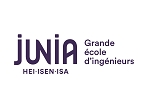Establishment
Language of instruction
French, English
Teaching content
MO-ST
Training officer(s)
AC.HLADKY
Stakeholder(s)
E.DUBOIS, AC.HLADKY
Présentation
Prerequisite
There are no particular prerequisites for students coming from the first year of engineer classes at ISEN
Goal
This class presents several aspects of scientific calculus.
First, it makes students aware of problems of numerical reliability (on a computer, one cannot represent exactly a finite number of values), through several methods frequently used in scientific calculus. Then, the class explains the finite element method, which allows the representation of a continuous medium with a mesh of small elements. This method is largely used in the aeronautic, naval, and aerospatial domains, and its development is based directly on the power of the computers. In this unit, lab work and a small project are proposed. By the end of this class, the student will be capable of putting into use a simple numerical method based on the finite element method.
First, it makes students aware of problems of numerical reliability (on a computer, one cannot represent exactly a finite number of values), through several methods frequently used in scientific calculus. Then, the class explains the finite element method, which allows the representation of a continuous medium with a mesh of small elements. This method is largely used in the aeronautic, naval, and aerospatial domains, and its development is based directly on the power of the computers. In this unit, lab work and a small project are proposed. By the end of this class, the student will be capable of putting into use a simple numerical method based on the finite element method.
Presentation
First part (Lecture 4 hours + Seminar 4 hours + Lab 4 hours):
Computer algorithms and their numerical errors.
General presentation of several basic methods used in scientific calculus:
interpolation and smoothing, numerical integration.
Second part (project): 4 hours of lab work
Presentation of a simple resolution method of partial differential equations. Application to the resolution of the Poisson equation
1) the Newton-Raphson method
2) Matrix inversion methods
3) Introduction to the spatial discretisation of 2nd order differential equations
4) Application to one-dimensional resolution of Poisson equation
Computer algorithms and their numerical errors.
General presentation of several basic methods used in scientific calculus:
interpolation and smoothing, numerical integration.
Second part (project): 4 hours of lab work
Presentation of a simple resolution method of partial differential equations. Application to the resolution of the Poisson equation
1) the Newton-Raphson method
2) Matrix inversion methods
3) Introduction to the spatial discretisation of 2nd order differential equations
4) Application to one-dimensional resolution of Poisson equation
Modalités
Forms of instruction
In this class, lab work and a small project are proposed, done on the computer, using Scilab software
Organization
| Type | Amount of time | Comment | |
|---|---|---|---|
| Face to face | |||
| Lectures - face to face | 8,00 | ||
| Exercises | 4,00 | ||
| Lab | 4,00 | ||
| Mini-project | 4,00 | ||
| Independent study | |||
| Independent study | 30,00 | ||
| Overall student workload | 50,00 | ||
Evaluation
The evaluation is based on lab work (first part) and a small project (second part) each counting for 50% of the final grade.






